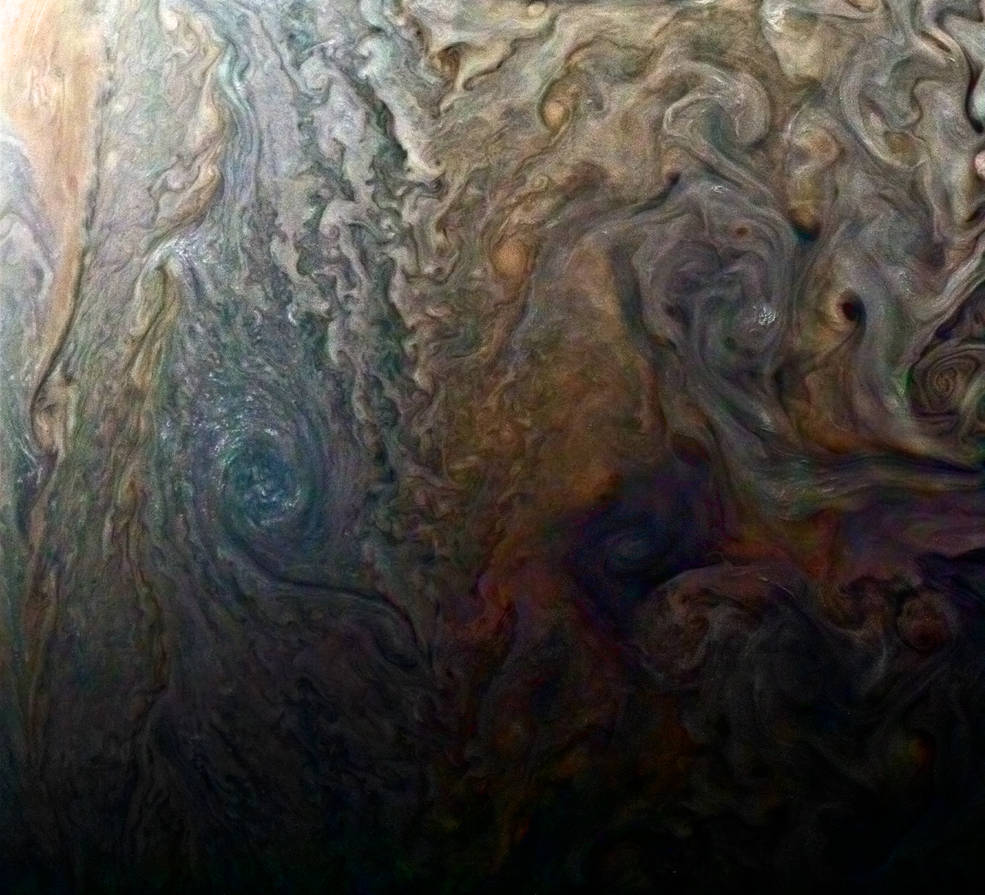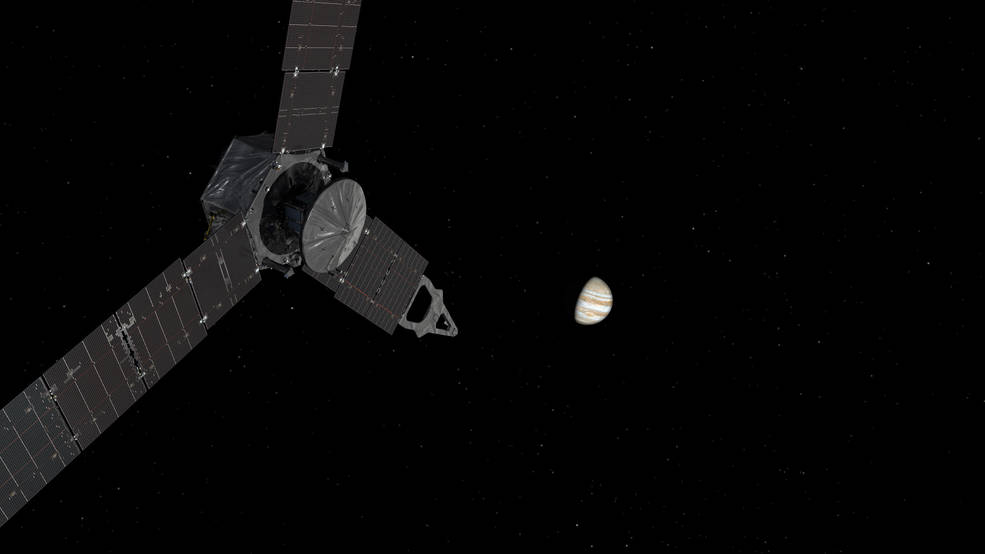This enhanced-color image of a mysterious dark spot on Jupiter seems to reveal a Jovian “galaxy” of swirling storms.
木星の神秘的な暗部を画像処理してみると、木星大気に渦巻く嵐の「銀河」のように見えてきます。
Credits: NASA/JPL-Caltech/SwRI/MSSS/Roman Tkachenko
オリジナル記事:NASA’s Juno Spacecraft Set for Fifth Jupiter Flyby
NASA’s Juno spacecraft will make its fifth flyby over Jupiter’s mysterious cloud tops on Monday, March 27, at 1:52 a.m. PDT (4:52 a.m. EDT, 8:52 UTC).
NASAの木星探査機ジュノーは、3月27日(月曜日)午後1時52分(午前4:52 EDT、8:52 UTC)に木星の神秘的な大気の上空を5回目となる近接通過する予定です。
At the time of closest approach (called perijove), Juno will be about 2,700 miles (4,400 kilometers) above the planet’s cloud tops, traveling at a speed of about 129,000 miles per hour (57.8 kilometers per second) relative to the gas-giant planet. All of Juno’s eight science instruments will be on and collecting data during the flyby.
最接近時(perijoveと呼んでいます)、ジュノーは木星大気上空約2,700マイル(4,400キロメートル)にあり、ガス巨大惑星である木星に対して時速約129,000マイル(毎秒57.8キロメートル)の速度で通過します。ジュノー搭載の8つの観測機器全て最接近時にデータ観測・収集します。
“This will be our fourth science pass — the fifth close flyby of Jupiter of the mission — and we are excited to see what new discoveries Juno will reveal,” said Scott Bolton, principal investigator of Juno from the Southwest Research Institute in San Antonio. “Every time we get near Jupiter’s cloud tops, we learn new insights that help us understand this amazing giant planet.”
「これは今回の探査活動では4回目の観測となります。木星の最接近としては5回目です。(最初は観測を実施していません)」と、サンアントニオのサウスウエスト研究所のジュノー主任研究員スコット・ボルトンが述べています。「木星の大気上空に接近するたびに、私たちはこの驚くべき惑星を理解するのに役立つ新しい発見を得ます。」
The Juno science team continues to analyze returns from previous flybys. Scientists have discovered that Jupiter’s magnetic fields are more complicated than originally thought, and that the belts and zones that give the planet’s cloud tops their distinctive look extend deep into the its interior. Observations of the energetic particles that create the incandescent auroras suggest a complicated current system involving charged material lofted from volcanoes on Jupiter’s moon Io.
ジュノー科学チームは、前回の最接近時の観測結果の解析・分析を続けているところです。科学者たちは、木星の磁場が元々考えられていたものよりも複雑であること、そして惑星の雲が独特な外観を呈するベルトやゾーンがその内部まで深くまで広がっていることを発見しました。白熱したオーロラを生成するエネルギー粒子の観測は、木星の衛星イオの火山から噴出された荷電物質を含む複雑なシステムになっていることを示唆しています。
Peer-reviewed papers with more in-depth science results from Juno’s first flybys are expected to be published within the next few months.
ジュノーの最初の最接近からのより詳細な学術調査結果をまとめた論文は、今後数ヶ月以内に発表される予定です。
Juno launched on Aug. 5, 2011, from Cape Canaveral, Florida, and arrived in orbit around Jupiter on July 4, 2016. During its mission of exploration, Juno soars low over the planet’s cloud tops — as close as about 2,600 miles (4,100 kilometers). During these flybys, Juno is probing beneath the obscuring cloud cover of Jupiter and studying its auroras to learn more about the planet’s origins, structure, atmosphere and magnetosphere.
NASA’s Jet Propulsion Laboratory, Pasadena, California, manages the Juno mission for the principal investigator, Scott Bolton, of Southwest Research Institute in San Antonio. The Juno mission is part of the New Frontiers Program managed by NASA’s Marshall Space Flight Center in Huntsville, Alabama, for the Science Mission Directorate. Lockheed Martin Space Systems, Denver, built the spacecraft. JPL is a division of Caltech in Pasadena, California.
More information on the Juno mission is available at:
http://www.nasa.gov/juno
http://missionjuno.org
The public can follow the mission on Facebook and Twitter at:
http://www.facebook.com/NASAJuno
Tweets by NASAJuno
DC Agle
Jet Propulsion Laboratory, Pasadena, Calif.
818-393-9011
agle@jpl.nasa.gov
Dwayne Brown / Laurie Cantillo
NASA Headquarters, Washington
202-358-1726 / 202-358-1077
dwayne.c.brown@nasa.gov / laura.l.cantillo@nasa.gov
2017-086
Last Updated: March 25, 2017
Editor: Martin Perez


